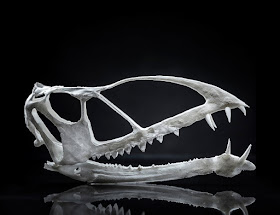 |
| Caelestiventus hanseni
Britt, Dalla Vecchia, Chure, Engelmann, Whiting & Scheetz, 2018
Illustration: Michael Skrepnick
|
Abstract
Pterosaurs are the oldest known powered flying vertebrates. Originating in the Late Triassic, they thrived to the end of the Cretaceous. Triassic pterosaurs are extraordinarily rare and all but one specimen come from marine deposits in the Alps. A new comparatively large (wing span >150 cm) pterosaur, Caelestiventus hanseni gen. et sp. nov., from Upper Triassic desert deposits of western North America preserves delicate structural and pneumatic details not previously known in early pterosaurs, and allows a reinterpretation of crushed Triassic specimens. It shows that the earliest pterosaurs were geographically widely distributed and ecologically diverse, even living in harsh desert environments. It is the only record of desert-dwelling non-pterodactyloid pterosaurs and predates all known desert pterosaurs by more than 65 Myr. A phylogenetic analysis shows it is closely allied with Dimorphodon macronyx from the Early Jurassic of Britain.
Systematic palaeontology.
Pterosauria Kaup, 1834
Dimorphodontidae Seeley, 1870
Caelestiventus hanseni gen. et sp. nov.
Etymology. Caelestiventus hanseni comes from the Latin language: caelestis, ‘heavenly or divine’, and ventus, ‘wind’, referring to the volant nature of pterosaurs, and ‘hanseni’, honouring Robin L. Hansen, Bureau of Land Management (BLM) geologist, who facilitated work at the Saints & Sinners Quarry
....
Conclusion:
Caelestiventus hanseni is the first record of a desert-dwelling, non-pterodactyloid pterosaur, predating by >65Ma all known desert occurrences of pterosaurs. It shows that in the Late Triassic—early in their evolution and diversification—pterosaurs were widely distributed and lived in a broad range of habitats, including inland deserts far (>800 km) from the sea. Despite their morphological similarity, C. hanseni and D. macronyx lived in very different environments. Dimorphodon was an island dweller45 in a humid climate46 and was preserved in the marine Blue Lias (Hettangian–Sinemurian) of southern England (Sangster, 2003). C. hanseni indicates that dimorphodontids originated by the Late Triassic and survived the end-Triassic extinction event
Brooks B. Britt, Fabio M. Dalla Vecchia, Daniel J. Chure, George F. Engelmann, Michael F. Whiting and Rodney D. Scheetz. 2018. Caelestiventus hanseni gen. et sp. nov. Extends the Desert-dwelling Pterosaur Record Back 65 Million Years. Nature Ecology & Evolution. DOI: 10.1038/s41559-018-0627-y
Rare triassic pterosaur discovered by BYU paleontologists news.byu.edu/node/11801 via @@BYU
Utah Pterosaur Was Desert-Dwelling Badass...Pelican? - Dead Things blogs.discovermagazine.com/deadthings/2018/08/13/utah-pterosaur/



